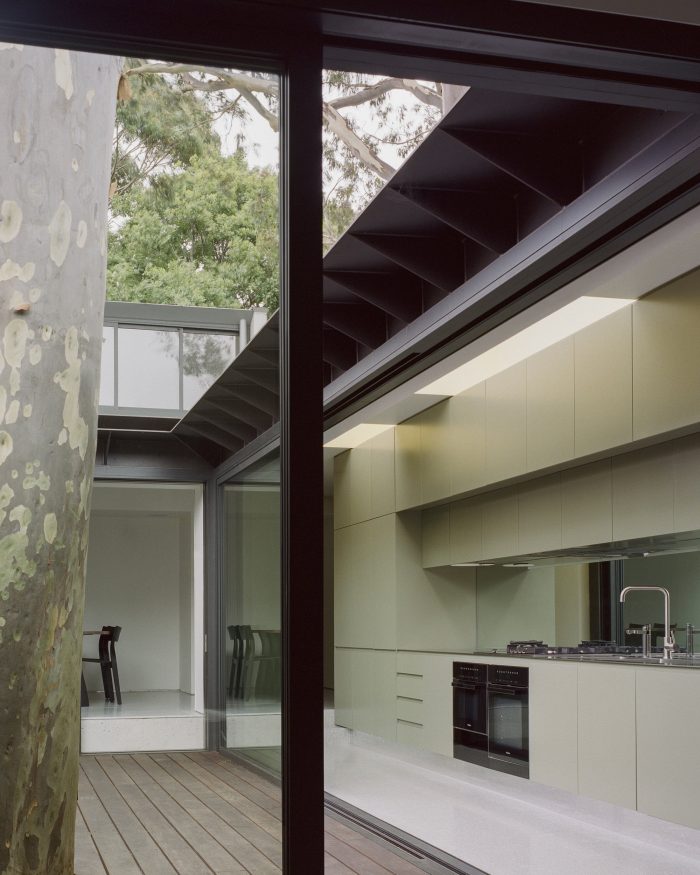作为悉尼市1970年恢复本地植被的举措的一部分,为了给城市的扩张让路,本地树苗被免费提供给公众。这一举措的遗留物之一,一棵20米高的斑叶树,是这个项目的核心,并形成了对Erskineville累积的城市密度的自然反衬。
As part of the City of Sydney’s 1970 initiative to reinstate native vegetation cleared to make way for the expansion of the city, native saplings were offered to the general public free of charge. One of the remnants of this initiative, a 20m high Spotted Gum, is central to this project and forms a natural counterpoint to the accumulated urban density of Erskineville.
整体规划图是以一个明确的内部庭院来开发的,以解决场地的狭窄宽度(4.8米)和不可避免的靠近斑点树的问题。这导致了一种隐蔽的透明感,新的生活区包裹着私人庭院,而现有的遗产结构则形成了对街道的保护性门槛。
The overall planning diagram was developed with a defined internal courtyard to address the narrow width of the site (4.8m) and the inevitable proximity of the Spotted Gum. This resulted in a sense of secluded transparency with the new living areas encasing the private courtyard whilst the existing heritage fabric formed a protective threshold to the street.
然后,计划的元素被操纵,以进一步纪念这个紧凑的院子。厨房被拉长以增加对庭院的暴露。客厅是下沉式的,通过玻璃门提供与天空和天幕的进一步联系。细木家具被着色,以回应斑桉不断变化的颜色,而楼梯是由斑桉建造的,以反映树木的力量和重要性。
Elements of the plan were then manipulated to further commemorate the compact courtyard. The kitchen was elongated to increase exposure to the courtyard. The living room is sunken to offer further connection to the sky and canopy via the glazed doors. The joinery was tinted to respond to the ever-changing colors of the Spotted Gum whilst stairs were constructed from Spotted Gum to reflect the strength and importance of the tree.
狭窄的场地和露台的类型导致了斑桉的存在被置于前景之中,除非人们垂直地看向树冠。这一特点激发了一系列的光圈,这些光圈介于水平的前景、从上面落下的斑驳的光线和垂直的树冠视野之间。每个开孔都使用几何学、方向、颜色和材料进行了微调,以提供与每个房间的功能要求和树的运动所提供的戏剧性相联系的一系列不同的气氛。在这样一个密集的城市环境中,这是一个罕见的现象。
The narrow site and terrace typology results in the presence of the Spotted Gum being experienced in the foreground, unless one looks vertically into the canopy. This characteristic inspired a series of apertures that mediate between the horizontal foreground view, the dappled light falling from above, and vertical views into the canopy. Each aperture was fine-tuned using geometry, orientation, color, and materiality to provide a diverse sequence of atmospheres linked to the functional requirements of each room and the drama provided by the movement of the tree. A rare phenomenon in such a dense urban environment.
厨房是由一系列雕刻好的孔洞定义的,其内表面涂成黄色,以确保进入树冠的视野总是感觉阳光充足。浴室由几何形的孔洞点缀,让人联想到土耳其浴室的光井。这些都是用深蓝色的瓷砖铺设的,以创造沐浴时在水下的氛围。流通区域被尖锐的三角形孔洞所穿透,以便在移动时有控制地瞥见天幕,并有直接光线照亮走廊。
The kitchen was defined by a series of sculpted apertures with the inner surfaces painted yellow to ensure the view into the canopy always felt sunny. Bathrooms were punctuated by geometric apertures that are reminiscent of the light wells found in Turkish baths. These were lined with dark blue tiles to create the atmosphere of being underwater whilst bathing. Circulation areas were pierced with acute, triangular apertures to offer controlled glimpses into the canopy whilst moving and shards of direct light to illuminate the hallways.
Architects: Lachlan Seegers Architect
Year : 2022
Photographs :Rory Gardiner
City:SYDNEY
Country:Australia






















